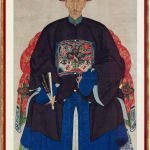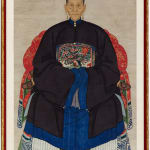Chui Xuchong
A very fine pair of Chinese late Qing dynasty ancestor portraits showing a senior official of the third rank and his wife by Chui Xuhong, inscribed on the fan held by the man Chui Xuchong shu, both sitters of respectable age, seated in hieratic posture on wooden chairs, the man with a moustache wearing a hat and richly ornamented court dress, the coat or pufa with a buzi or Mandarin square featuring a peacock identifying him as a senior civil official of the third rank, his wife with hair worn up, earrings and pufa and also with buzi ornamented with a peacock
China, late nineteenth century, Qing Dynasty
Gouache on paper
159 x 81 cm. each.
These extremely fine Chinese commemorative portraits, commonly referred to as ancestor paintings, were painted specifically for use in ancestral worship since it was assumed that the power of the living person resided in their portrait after death. The Chinese have long had a profound connection to their forebears in the belief that death does not curtail a person’s relationship with the living and that, if properly worshipped and honoured in private family rituals, the spirits of their ancestors can bring them health, long life, prosperity and children, who will someday similarly honour their parents. In Imperial China and, as part of their sacred family duty to care for the spirits of their deceased ancestors, sons of all classes, paid homage to their ancestors in ritual ceremonies in which they placed food offerings before the portraits.
The majority of surviving ancestor portraits depict members of the Qing Imperial families and military and civil elite who ruled China from 1644 up until the revolution of 1911 of which the present pair are extremely fine examples from the late nineteenth century. As here the husband and wife, who sit for their portrait were almost always depicted nearly live-size in a frontal pose, usually seated in an elaborately carved chair draped in fur or as here in brocade. Likewise all of the ancestors wore semiformal winter gowns decorated with elaborate insignia that announced their rank or princely status. Here we see a peacock, symbol of beauty and dignity and the emblem of a scholarly official of the third rank.
These remarkable examples are made even more rare since with the introduction of photography during the nineteenth century, the painting of ancestor portraits began to diminish. However, although people then tended to be photographed rather than painted, today such photographic portraits continue to hold a central place within the Chinese tradition of ancestral worship.



